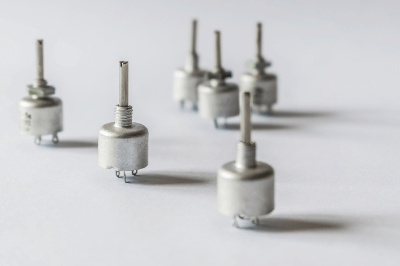What Is a Potentiometer?

A potentiometer is a device or element that converts the angle of rotation or the amount of movement into a voltage.
It consists of a resistive element and a sliding element (wiper) that moves on the surface of the resistive element, and the resistance value can be freely varied by moving the sliding element.
Thus, potentiometers are a form of variable resistance, and in English-speaking countries, variable resistors are called potentiometers.
Uses of Potentiometers
1. Variable Resistance
Potentiometers are used to adjust the amount of current and voltage. Because of their ability to be freely set to any desired resistance value, potentiometers fulfill the above circuit roles.
Potentiometers are used in consumer products such as volume controls for audio equipment and controllers for game consoles.
2. Displacement Sensor
Potentiometers also function as displacement sensors. A displacement sensor is one that can measure the distance to an object to be measured and its dimensions.
If the position of a wiper on a car or other object changes when it is moved, the displacement sensor function can be used to measure the distance and dimensions of the object. Potentiometers, which are inexpensive and relatively accurate, are also used in applications for industrial equipment.
Examples include marine equipment, medical equipment, construction machinery, and machine tools.
Principle of Potentiometers
1. Method of Determining Resistance
When the sliding element (moving part) of a potentiometer moves over a resistive element, the resistance value is determined by where the resistive element stops. A constant voltage is applied to the two terminals coming from the resistive element, and the third terminal produces an output that varies depending on the position at which the sliding element (wiper) moves.
Since the surface of the resistive element is coated with a uniform resistive material, the resistance per length of the resistive element is the same, and the resistance is determined by the position of the sliding element (wiper).
2. Application to Displacement Sensor
Using the above mechanism, the amount of displacement is measured from the actual output voltage. The result of this measurement can be used as a displacement sensor.
Furthermore, it can be used to input an analog amount to a system controller for control or to detect the output state of a servomotor.
Types of Potentiometers
There are two types of potentiometers: linear potentiometers and rotary potentiometers. The former type detects a linear position, while the latter type detects a rotational angle.
The rotary type comes in single and multi-turn types, which use conductive plastic or other materials. They are carefully manufactured to ensure that the change in resistance is linear with respect to the amount of movement in order to increase accuracy.
Other classifications include contact and non-contact types. Contact types include the cermet resistive element type, which is a mixture of ceramic and metal, the wire-wound resistive element type, and the conductive plastic resistive element type.
Other Potentiometer Information
Digital Potentiometers
In contrast to the analog potentiometers described above, digital potentiometers are devices that cover these shortcomings. It refers to an electronic component that sets the sliding part of an analog potentiometer on the controller side.
The collective resistance existing inside the IC is switched under control from the controller. Since there are no moving parts, there is no wear and tear, and highly accurate resistance values can be obtained stably and without noise. This is why they are characterized by long life and high performance.
Since analog and digital potentiometers have individual characteristics, it is important to determine which type to use based on the specifications and cost required by the circuit to be used.